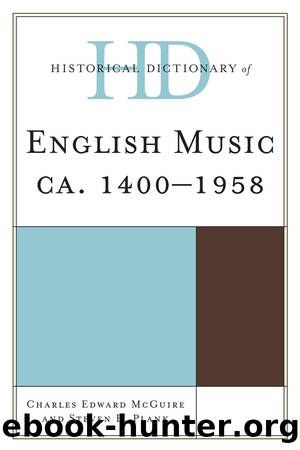Historical Dictionary of English Music by McGuire Charles Edward. Plank Steven Eric. & Plank

Author:McGuire, Charles Edward.,Plank, Steven Eric. & Plank [McGuire & Plank]
Language: eng
Format: epub
Publisher: Scarecrow Press Inc.
Published: 2011-03-15T00:00:00+00:00
I
IMMYNS, JOHN (1724â64). Amateur musician and lawyer. Immyns was largely self-taught as a musician, learning to play the lute from a 17th-century method book. His skill became great enough that he was named lutanist of the Chapel Royal in 1752. He also founded the Madrigal Society, was a member of the Academy of Ancient Music, and was a copyist for both it and Johann Christoph Pepusch.
IN NOMINE. A cantus-firmus based genre of fantasia, arising ca. 1530, with examples through the end of the 17th century. In nomines were written for keyboards, lute, and consort, with the latter scoring the most prominent. The cantus firmus on which these fantasias is based is the antiphon Gloria tibi trinitas, from the second Vespers of Trinity Sunday. The nominal reference âIn nomineâ derives from the polyphonic Benedictus (including the text phrase âin nomineâ) from John Tavernerâs Missa Gloria tibi Trinitas, which was transcribed for instruments, likely the first example of what would become an important instrumental genre. See also ALWOOD, RICHARD; BLITHEMAN, JOHN; BROWNING; PARSLEY, OSBERT; TALLIS, THOMAS; TYE, CHRISTOPHER; VIOL; WARD, JOHN; WHYTE, ROBERT.
IRELAND, JOHN (1879â1962). Composer, pianist, teacher, organist, and choirmaster. During his life, Ireland was known mostly for his piano works; he also wrote excellent songs such as the popular âSea Feverâ and a few choral and orchestral works. Ireland had early training at the Royal College of Music (RCM), where he studied piano (1893â97) and composition with Sir Charles Villiers Stanford (1897â1901). He earned an FRCO in 1895 and a BMus from Durham University in 1905. He supported himself through school with various jobs, including as organist at Holy Trinity, Sloane Street, and St. Judeâs, Turkâs Row; Ireland was later organist and choirmaster at St. Lukeâs, Chelsea (1904â26), and taught composition at the RCM (1920â39), where his students included Benjamin Britten, Alan Bush, and others. Early success in composition came with winning a Cobbett Prize in 1912; in the late 1910s and early 1920s, his reputation grew, especially in London. Following his retirement from the RCM, he gradually stopped composing, living the remainder of his years quietly in West Sussex.
ISAACK, BARTHOLOMEW (1661â1709). Singer, organist, composer. Isaack was trained as a chorister in the Chapel Royal in the mid-1670s, at which time he may also have sung in John Crowneâs court masque Calisto (1674/75). He was in Ireland for a time, holding appointments at both Christ Church Cathedral, Dublin (1684), and St. Patrickâs Cathedral, Dublin (1685â87). He reemerged in the English musical scene in 1705 as organist at Southwark. The career of his brother, Peter (d. 1694), was interestingly parallel, including training in the Chapel Royal and Irish appointments at both Dublin cathedrals. Peter returned to England to take up appointment at Salisbury Cathedral (1687), but he returned to Dublin in 1692.
Download
This site does not store any files on its server. We only index and link to content provided by other sites. Please contact the content providers to delete copyright contents if any and email us, we'll remove relevant links or contents immediately.
The Goal (Off-Campus #4) by Elle Kennedy(13212)
Kathy Andrews Collection by Kathy Andrews(11344)
Diary of a Player by Brad Paisley(7272)
What Does This Button Do? by Bruce Dickinson(5938)
Assassin’s Fate by Robin Hobb(5867)
Big Little Lies by Liane Moriarty(5528)
Altered Sensations by David Pantalony(4877)
Pale Blue Dot by Carl Sagan(4632)
Sticky Fingers by Joe Hagan(3916)
The Death of the Heart by Elizabeth Bowen(3348)
The Heroin Diaries by Nikki Sixx(3328)
Beneath These Shadows by Meghan March(3157)
Confessions of a Video Vixen by Karrine Steffans(3108)
The Help by Kathryn Stockett(3024)
How Music Works by David Byrne(2969)
Jam by Jam (epub)(2882)
Harry Potter 4 - Harry Potter and The Goblet of Fire by J.K.Rowling(2818)
Strange Fascination: David Bowie: The Definitive Story by David Buckley(2704)
Petty: The Biography by Warren Zanes(2579)
